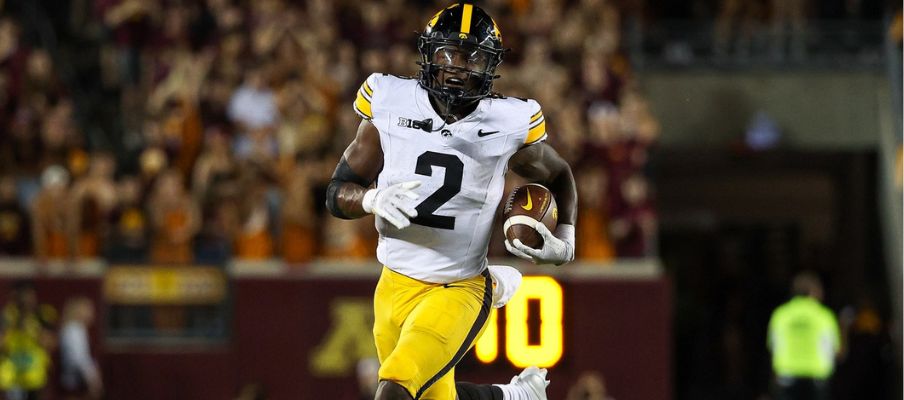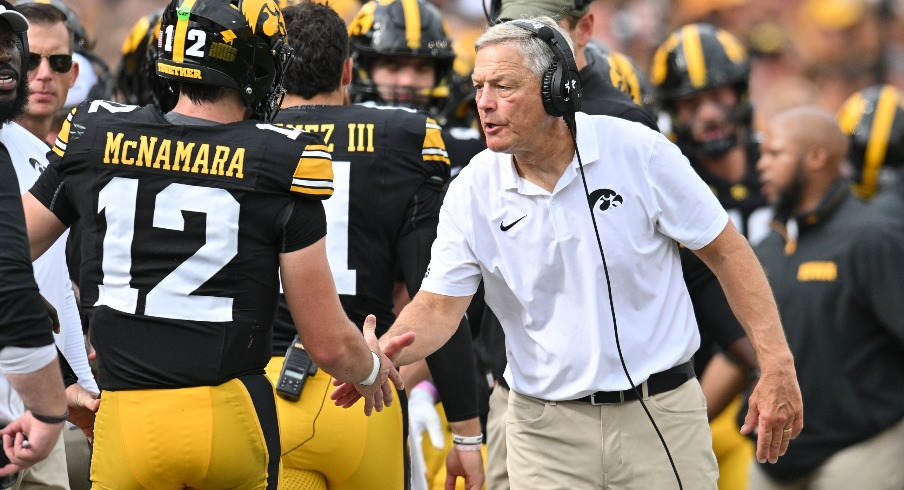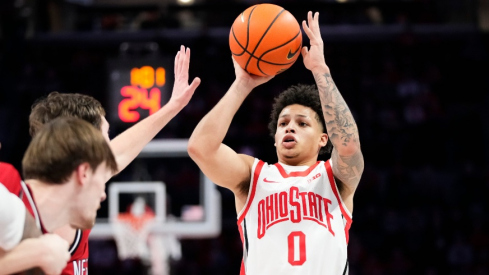The first half of Ohio State's schedule always felt like a ramp, and the incline is nearing its crest in Week 6.

One week after it passed its first Big Ten test on the road against Michigan State with flying colors and one week before it faces its ultimate midseason exam at No. 6 Oregon, Ohio State welcomes an Iowa team with a familiar look into the Shoe for a Saturday matinée.
The Hawkeyes have been driven by defense since their 12-0 regular season back in 2015, and their 2024 squad is no different – if less extreme than in recent years. Iowa's secondary has shown some vulnerability while its offense has shown some life in the running game, and any sign of life anywhere is an improvement on that side of the ball for the gold and black.
Off the field, Iowa's nickname is rooted in a complicated state tradition that might trace its roots to a famed 1826 novel.
The court Lester
One must be careful speaking in absolutes. But it's hard to call what was perpetrated with Iowa's offense in the late 2010s and early 2020s anything other than nepotism.
| YEAR | PPG (RANK) | YPG (RANK) |
|---|---|---|
| 2017 | 28.2 (69th) | 329.1 (117th) |
| 2018 | 31.2 (44th) | 375 (92nd) |
| 2019 | 25.8 (87th) | 366.5 (99th) |
| 2020 | 31.8 (40th) | 368.6 (88th) |
| 2021 | 23.4 (99th) | 303.9 (121st) |
| 2022 | 17.7 (123rd) | 251.5 (130th) |
| 2023 | 15.4 (132nd) | 234.6 (133rd) |
Note: There were 130 teams in college football from 2017-21, 131 in 2022 and 133 in 2023.
In 2023, former Iowa offensive coordinator Brian Ferentz, son of head coach Kirk Ferentz, came nowhere near the 25 points per game his new contract stipulated he needed to return in 2024. The team announced it'd be letting him go midseason. The Hawkeyes were in the bottom 33% of college football for total offense during Brian's entire seven-year stint.
Former Western Michigan head coach turned Green Bay Packers analyst Tim Lester got the nod to replace Brian Ferentz ahead of the 2024 season. Lester coached the Broncos from 2017-22 and was fired after a 5-7 campaign in his final year. Western Michigan struggled offensively in his final year but ranked top 25 nationally in yards per game from 2019-21. Lester was last an offensive coordinator for Syracuse in 2014 and 2015, and the Orange ranked 116th and 118th in total yardage those seasons.
It's been an up-and-down career for Lester. But there's no doubt Iowa's offense has improved under his guidance in 2024.
The Hawkeyes have gone from one of the worst attacks in college football and easily the worst in the Big Ten to mediocre. That's a massive step in the right direction. Four games isn't a large sample size, but Iowa is 53rd nationally with 32 points per game and 65th with 397.8 yards.
It all comes on the ground. Iowa is 10th in the country with 250.3 yards per game and 11th with 6 yards per carry. The Hawkeyes are 124th in passing. They're one-dimensional, but that's better than having no dimension at all as they did in the final few years of the Brian Ferentz era.
The Sweet Feet From Cincy

Running back and Cincinnati native Kaleb Johnson is the main man to thank for Iowa's offensive strides.
Enjoying a breakout junior season, Johnson is second in college football with 685 rushing yards and tied for third with nine touchdowns. He's averaging a blistering 8.4 yards per carry.
The Hawkeyes' last game was Johnson's best yet, a 21-carry, 206-yard, three-touchdown outing against rival Minnesota in the battle for the Floyd of Rosedale. Iowa carried home the bronze pig in a 31-14 road victory.
Stout run defense
As bad as Iowa's offense was in the final three years of Brian Ferentz's tenure, its defense was good in almost equal measure. The Hawkeyes ranked top five nationally in points allowed per game in 2022 and 2023.
Iowa's defense is off to another strong start in 2024, ranked 15th in points allowed and 18th in yards allowed per game. Where the Hawkeyes excel is in stopping opposing ground attacks, surrendering just 62 rushing yards per game, fourth-fewest in the nation behind the 61.8 yards per game Ohio State's defense allows.
Linebacker Jay Higgins leads the charge, fresh off of a 171-tackle season in 2023. He's got 34 takedowns in four games this year, plus he's a turnover threat with two interceptions and a forced fumble. Nick Jackson, the owner of four consecutive 100-tackle seasons at Virginia and Iowa, accompanies him. He's second on the squad with 25 tackles, adding a sack and three pass breakups.
Aaron Graves and Yahya Black make a disruptive combo at defensive tackle, each weighing in at more than 300 pounds. Graves has three sacks and Black has 2.5 tackles for loss. The duo have 20 tackles combined.
There has been some success throwing the ball against Iowa, as the Hawkeyes are just 69th in passing yards allowed per game with 210.8. Iowa State beat Iowa in the Cy-Hawk series 20-19. The Cyclones threw for 272 yards against the Hawkeyes, a chunk of which set up a game-winning 54-yard field goal off the leg of Kyle Konrardy.
Cornerback Jermari Harris can be dangerous, however, with two interceptions and five PBUs on the season.
The Wave
This one will be brief, especially since the Buckeyes aren't playing the Hawkeyes at Kinnick Stadium this Saturday. But you can't have a broad-scope article about the program without mentioning one of the coolest traditions in college football.
After the first quarter of each Iowa home game, the entire stadium – home fans, opposing fans, home players, opposing players – turns to wave at the University of Iowa Health Stead Family Children's Hospital, the top few floors of which overlook the field.
The hospital opened in 2017, and that year an Iowa fan named Krista Young suggested that fans take time to wave at the windows that had a clear view into Kinnick. It caught traction on social media, and after the first quarter of Iowa's game against Wyoming that year, the stadium delivered. They've been doing it every home contest since.
Last of the Mohicans
Iowa is the Hawkeye State. That's all the explanation needed to surmise why the University of Iowa's athletics teams are called the Hawkeyes.
But why is Iowa the Hawkeye State? That answer is much more complex. It starts with James Fenimore Cooper's famed 1826 novel The Last of the Mohicans, which has since been adapted to film twice, the more famous of which was released in 1992 and starred Daniel Day-Lewis.
The Last of the Mohicans is set in what is now New York and written by a New Jersey man, but the story goes that a judge in Burlington, Iowa, named David Rorer felt the territory of Iowa should give itself a nickname to avoid getting a derogatory one from neighbors. His friend, James G. Edwards, ran Burlington's newspaper, then called the Iowa Patriot. At Rorer's behest that the state needed a nickname, Edwards changed the paper's name to The Burlington Hawk-Eye and Iowa Patriot.
This is where accounts differ. One says that Borer recommended the Hawkeye name to Edwards after a character in The Last of the Mohicans named "Hawkeye." The other says that Edwards did it as a tribute to two friends of his, Chief Black Hawk and Stephen Sumner Phelps, a fur trader named "Hawkeye" by the Meskwaki Nation, a Native American tribe in Iowa.
Still, some think that it could be both, and the popularity of the character in Cooper's novel at the very least helped the nickname to stick over the years. Either way, Edwards put out the following call in The Burlington Hawk-Eye in September 1839, and 185 years later the name is a staple of Iowa's lore:
If a division of the territory is effected, we propose that the Iowans take the cognomen of Hawk-eyes. Our etymology can then be more definitely traced than can that of the Wolverines, Suckers, Gophers, etc., and we shall rescue from oblivion a memento, at least, of the name of the old chief. Who seconds the motion?
Clearly, many did second the motion.


